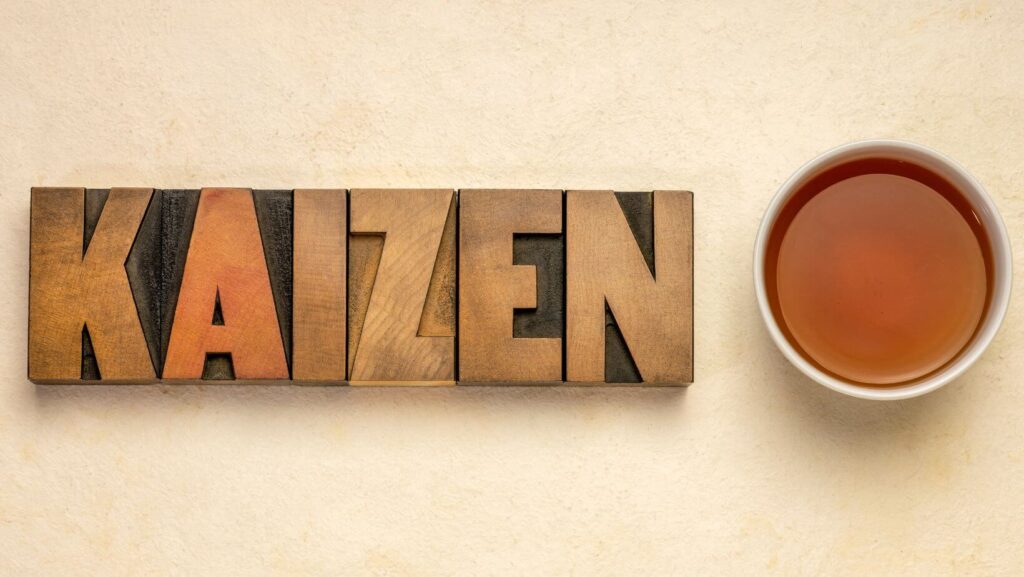Table of Contents
ToggleKaizen, also known as the suggestion system, employee idea, improvement suggestion, or improvement idea, although it is called differently, is the basic pillar of improving companies within the lean culture. What is kaizen, what is its essence, and what are the benefits you will find out after reading this article?
What is Kaizen?
Kaizen is a Japanese word that means “continuous improvement”. The term is inseparably linked to Japanese management and production philosophy, particularly the approach known as Lean Manufacturing. The Kaizen philosophy assumes that everyone in their professional and personal lives should constantly strive for excellence. As a business philosophy, Kaizen involves the continuous elimination of all kinds of waste and the constant involvement of employees in every area of the production process.
The essence of Kaizen
Kaizen, a concept deeply rooted in Japanese management philosophy, represents the pursuit of continuous improvement in both personal and professional contexts. At its core, Kaizen is founded on the principle that no process, no matter how efficient or effective it currently is, is beyond the scope of improvement. This philosophy encourages a perpetual cycle of enhancement, where even the smallest changes are valued for their potential to contribute to the overall betterment of a system or process.
The term “Kaizen” itself is a fusion of two Japanese words: “kai” (改), meaning “change,” and “zen” (善), meaning “good” or “for the better.” This fusion underscores the philosophy’s emphasis on positive, incremental changes. Unlike strategies that seek monumental, disruptive innovations, Kaizen is about evolution rather than revolution. It posits that ongoing, minor modifications, frequently derived from the insights and experiences of those directly involved in the processes, can lead to significant improvements over time.
Benefits of implementing
The benefits of implementing Kaizen are primarily the ability to increase work efficiency and product and service quality, which affects customer satisfaction and thus the company’s market position. In addition, it can bring many other benefits, such as:
- Increased employee satisfaction. It encourages employees to participate in process improvement and contribute to the development of the organization. This makes employees more engaged and motivated. It supports a standardized process (SOPs, Training)
- Improved workplace safety. It allows for the identification of areas that require improvement in terms of workplace safety, which can help prevent accidents and occupational diseases.
- Reduced costs. It enables the identification and elimination of waste and the streamlining of processes, resulting in reduced production and service costs.
Kaizen and TWI Job Methods
Kaizen involves every employee in the process of identifying inefficiencies and suggesting small, continual improvements. Unlike TWI Job Methods, which initially focused on managerial training, Kaizen engages all levels of an organization in the improvement process.
Link Between TWI Job Methods and Kaizen
- Focus on Continuous Improvement: Both approaches emphasize ongoing, incremental changes rather than large-scale, transformative innovations. They advocate for regular assessment and modification of processes to enhance efficiency and productivity.
- Employee Involvement: While TWI Job Methods began with a focus on supervisors, it inherently involves employees in the process of job analysis and reorganization. Kaizen explicitly involves employees at all levels in suggesting and implementing improvements. This inclusive approach helps in fostering a culture of collective responsibility and continuous improvement.
- Efficiency and Productivity: Both methodologies aim to optimize processes to achieve greater efficiency and productivity. They encourage scrutinizing every aspect of a job or process to identify and eliminate waste, whether it be in time, resources, or effort.
- Post-World War II Context: Interestingly, both methodologies have their roots in the industrial challenges of the World War II era and its aftermath. TWI addressed the immediate wartime needs of the U.S., while Kaizen was part of Japan’s broader strategy for economic recovery and growth following the war.
- Global Influence: Both TWI Job Methods and Kaizen have transcended their original contexts and have been adopted worldwide. They are recognized as fundamental components of quality management and lean manufacturing practices in various industries.
While TWI Job Methods and Kaizen originated from different geographical and historical contexts, they converge in their fundamental objective of continuous, incremental improvement. Both methodologies have had a profound impact on modern management practices, emphasizing the importance of efficiency, employee involvement, and the never-ending pursuit of perfection in all processes.
Summary
This approach allows for great changes in small steps and is a universal tool that works in every company and every industry. It is linked with the 5W1H approach. By focusing on the continuous improvement of processes and the highest possible quality of products or services by involving all employees in the improvement process, all waste can be minimized. According to Kaizen, there are no perfect processes, everything can be improved, and the improvement process is never-ending.
I have many years of experience in the automotive industry. I am equipped with knowledge of KAIZEN culture and philosophy, as well as improvement tools based on real industrial conditions. I know how to identify and reduce waste in a company using lean management methods and tools. I am prepared to implement Lean Management tools and improvements that focus on improving the quality, efficiency, and productivity of processes.







